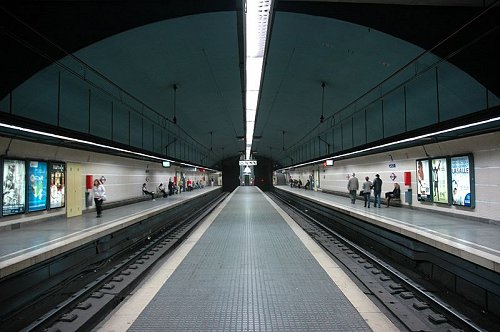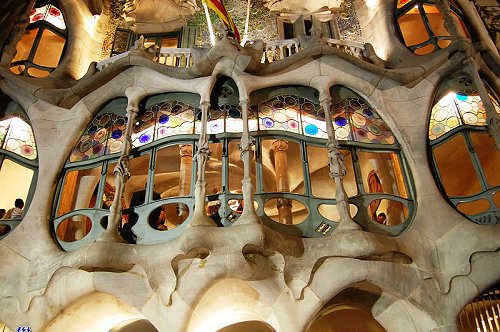 Barcelona, Spain
Barcelona, SpainSource: https://commons.wikimedia.org/wiki/File:Barcelona_panorama_from_Parc_Guell_-_Jan_2007.jpg
Author: Diliff

Barcelona, the capital of Catalonia, is the second biggest city in Spain and the sixth most populous urban area in the European Union behind Paris, London, the Ruhr area, Madrid and Milan. The city is the financial and commercial center of Catalonia. It is also a major port on the Mediterranean Sea and also a major international airport. Barcelona is the fourth biggest tourist destination in Europe after London, Paris and Rome.
 Sagrada Familia, the most famous icon of Barcelona
Sagrada Familia, the most famous icon of BarcelonaSource: https://commons.wikimedia.org/wiki/File:Sagrada_Familia_02.jpg
Author: Bernard Gagnon

Barcelona is located on the northeast part of Spain, between two rivers, the Llobregat and the Besòs. On the western side of the city is the Serra de Collserola ridge, which rises to 512 meters. The city enjoys a Mediterranean climate. Summers are warm while the winters are mild.
 Cathedral of Barcelona
Cathedral of BarcelonaSource: https://commons.wikimedia.org/wiki/File:Cathedral_of_Santa_Eulalia_Barcelona.JPG
Author: Jorge Lascar

When to visit Barcelona
In winter - January and February - you can enjoy a cool weather with little rain. On the other hand, August is when most people staying in Barcelona go away for their vacation, so many business may be closed. On the other hand, the hotels slash their prices as business is low during that month. For the most comfortable weather, visit between April and June, and between September and November. Tomb of St Eulalia, the patron saint of sailors, at the Cathedral of Barcelona
Tomb of St Eulalia, the patron saint of sailors, at the Cathedral of BarcelonaSource: https://commons.wikimedia.org/wiki/File:Tomb_of_Saint_Eulalia,_Cathedral_of_Barcelona.jpg
Author: Canon in 2D

Going to Barcelona
Barcelona International Airport (BCN) is one of the major airports in Europe. The airport is located 18 km from downtown Barcelona. It comprises two terminals, T1 and T2, which are miles apart. T1 is a new Terminal 1 serving mostly international airlines. Budget carrier easyJet flies to T2. Santa Maria del Mar interior, Barcelona
Santa Maria del Mar interior, BarcelonaSource: https://commons.wikimedia.org/wiki/File:Santa_Maria_del_Mar_-_Nau_interior.JPG
Author: Josep Renalias

If you arrive at T2, you can take the RENFE C-2 suburban train to downtown Barcelona. If you arrive at T1, you can take a bus service to the train station at T2. The fare is €1.40 for a single journey ticket or €7.85 for a 10-journey ticket. Alternatively, you can take public buses from both terminals to downtown.
If you fly by Ryanair, you will arrive at the airport in Girona, some 100 km to the north. From there, you can take the Barcelona Bus to the Estació del Nord station in downtown. The ticket costs €12 one day and €21 return.
 Torre Agbar, Barcelona
Torre Agbar, BarcelonaSource: https://commons.wikimedia.org/wiki/File:Barcelona125.jpg
Author: Miguel Carminati

Getting around in Barcelona
The Barcelona metro is perhaps the most practical way to explore the city. It uses the same ticket as the train from the airport, with the fare being €1.40 for a single journey ticket or €7.85 for a 10-journey ticket. The metro runs from 5:00 am to 12:00 midnight on Mondays to Thursday, till 2:00 am on Fridays, and 24 hours on Saturdays. The metro is operated by two companies, TMB for lines 1, 2, 3, 4, 5 and 11 and FGC for 6, 7 and 8. When you hold the 10-journey T-10 ticket, you can change between lines without paying additional charge when you transfer. However, if you hold the one-journey ticket, you need to get a new one for each transfer.If you plan to use the metro a lot, and don't want to be bothered with counting the number of rides, get the Barcelona Card, which allows for unlimited rides as well as discounts for entry to some 100 tourist attractions. The Barcelona Card costs €24 for 2 days and €34 for 5 days. These are worthwhile if you intend to spend lots of time visiting museums and art galleries.
 Estació de Muntaner subway station, Barcelona
Estació de Muntaner subway station, BarcelonaSource: https://commons.wikimedia.org/wiki/File:Estaci%C3%B3_de_Muntaner.JPG
Author: Josep Renalias

 Palau de la Música Catalana
Palau de la Música CatalanaSource: https://commons.wikimedia.org/wiki/File:Palau_de_la_Musica_Catalana_-_interior_1.jpg
Author: Montrealais

 Barceloneta
BarcelonetaSource: https://commons.wikimedia.org/wiki/File:Barceloneta_7_%28by_Awersowy%29.jpg
Author: Awersowy

 Casa Milá, Barcelona
Casa Milá, BarcelonaSource: https://commons.wikimedia.org/wiki/File:Barcelona_Casa_Mila_01.jpg
Author: German Ramos

 Plaça d'Espanya, Barcelona
Plaça d'Espanya, BarcelonaSource: https://commons.wikimedia.org/wiki/File:Montjuic_Placa_Espanya_Barcelona.jpg
Author: Baikonur

 Cazsa Batlló, Barcelona
Cazsa Batlló, BarcelonaSource: https://commons.wikimedia.org/wiki/File:CasaBatllo_0171.JPG
Author: tato grasso

Sights in Barcelona Old Town
- Arc del Triomf
The main gateway of the 1888 Universal Exhibition in Barcelona. - Barcelona Cathedral
Gothic style cathedral with a Romanesque chapel dating back to the 12th century. - Barceloneta
An area of seafood restaurants jutting out into the sea from the city, - Barri Gòtic
The oldest part of Barcelona and the heart of the city. - Basílica de Santa Maria del Mar
The only church in the Catalan Gothic style that took 55 years to build. - Carrer Montcada
An authentic medieval street in Barcelona. - Casa de la Ciutat
14th century city hall of Barcelona. - Casa de l'Ardiaca
Archdeacon's House, located beside the Bishop's Gate in the Roman wall. - Conjunt Monumental de la Plaça del Rei
Complex including the Royal Palace and the Museu d'Història de la Ciutat. - El Born
A village-like enclave within La Ribera district popular with young urbanites. - La Llotja
1771 Neo-Classical building that once housed the Barcelona Stock Exchange until 1994, and the Barceolona School of Fine Arts (1849-1970). - Las Ramblas
Busy historic tree-lined avenue in Barcelona. - El Raval
District of Barcelona near the port area. - Golondrinas
Double decker boats that take tourists sightseeing Barcelona's harbor. - Mercat del Born
The main wholesale market for Barcelona until the early 1970's. Archaeological excavation under the market revealed streets and homes from the 18th century. - Monument a Colom
Monument to Christopher Columbus standing at the Portal de la Pau. - Museu d'Art Contemporani
State-of-the-art museum building showcasing the city's art collection. - Museu de Geologia
Barcelona's oldest museum, opened in 1882. - Museu de la Xocolata
Museum of chocolates, founded by the chocolate and pastry-makers union of Barcelona. - Museu de Zoologia
Zoological museum, housed since 1937 in a crenellated brick building from the 1888 Universal Exhibition. - Museu Frederic Marès
Museum showcasing the eclectic taste of sculptor Frederic Marès i Deulovol. - Museu Marítim and Drassanes
Maritime museum housed in the former shipyards (Drassanes) of Barcelona. - Museu Picasso
Museum to the great artist housed in five adjoining medieval palaces. - Palau de la Generalitat
Seat of the Catalonian Governor. - Palau de la Música Catalana
Concert hall completed in 1908. - Parc de la Ciutadella
Public park with a boating lake. - Parc Zoològic
Zoo with aquarium designed in the 1940. - Port Olímpic
The 4-km promenade and new waterfront that was laid out in conjunction with the 1992 Olympics. - Port Vell
Barceolona's new leisure port with passenger pier, pedestrian jetty and yacht clubs.
Sights in Eixample
Eixample is the "new town" section of Barcelona dating to the early 19th century.- Casa Milá
Also called La Pedrera, the last work by Gaudi before he devoted himself to Sagrada Familia. - Casa Terrades
Free-standing, six-sided apartment block by Modernista architect Puig i Cadafalch. - Fundaciò Antoni Tapies
Iron building exhibiting the works of Antoni Tapies, the best-known living artist in Barcelona. - Hospital de la Santa Creu i de Sant Pau
Innovative hospital designed by Lluis Domènech i Montaner in 1902. - Illa de la Discòrdia
City block in Barcelona with the most famous Modernista buildings. - Quadrat d'O
Quarter of Barcelona containing some of its best Modernista buildings. - Sagrada Família
The most astounding church building in Europe, filled by symbolisms inspired by nature.
Sights in Montjuïc
Monjuïc is the southern precinct of Barcelona, a place of museums, art galleries and nightclubs.- Castell de Montjuïc
18th-century castle at the top of Montjuïc. - Estadi Olímpic de Montjuïc
Stadium in the Neo-Classical style, originally built in 1936 for the Alternative Olympics, was refitted for the 1992 Olympics. - Fundació Joan Miró
Gallery housing the works of Joan Miró, which includes paintings, sculptures and tapestries. - Museu Arqueológic
Museum within a 1929 Renaissance-inspired building housing artifacts from the Barcelona area from prehistory to the Visigothic period. - Museu Nacional d'Art de Catalunya
Museum housed in the Palau Nacional, built for the 1929 International Exhibition, housing one of the most important collection of art in Barcelona. - Pavelló Mies van der Rohe
German pavilion, designed for the 1929 International Exhibition by Ludwig Mies van der Rohe. - Plaç d'Espanya
Road junction with fountain, formerly a site of public gallows. - Poble Espanyol
Ensemble showcasing the architectural style and crafts of Spain, laid out for the 1929 International Exhibition.
Sights near Barcelona
- Cosmocaixa - Museu de la Ciència
Science museum with interactive exhibits. - Monestir de Santa Maria de Pedralbes
Monastery founded in 1326 by Elisenda de Montcade de Piños, fourth wife of Jaime II of Catalonia and Aragón. - Museu del Futbol Club Barcelona
Museum at Camp Nou, Europe's largest football stadium, home to the Barcelona FC. - Palau Reial de Pedralbes
Palace complex belonging to Count Eusebi Güell, who offered it to the Spanish royal family in 1919, with museums and garden that are open to the public. - Parc de Joan Miró
Palm on two levels, built on the site of a 19th century slaughterhouse. - Parc de l'Espanya Industrial
Modern park with canals and rowing lake designed in the 1980's. - Parc Güell
Antoni Gaudi's flamboyant creation, today a World Heritage Site. - Tibidabo
Hill with panoramic views of Barcelona. - Torre de Collserola
288-meter tower designed by NOrman Foster for the 1992 Olympic Games, on the submit of a 445-meter hill.
 Latest updates on Penang Travel Tips
Latest updates on Penang Travel Tips

Copyright © 2003-2025 Timothy Tye. All Rights Reserved.

 Go Back
Go Back